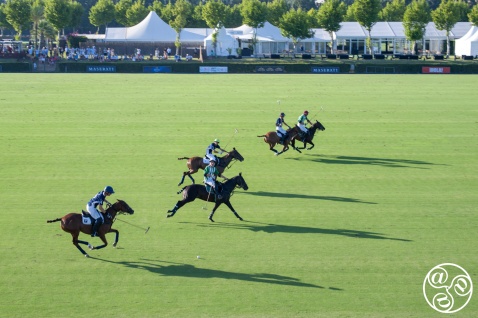
Polo, often dubbed the "sport of kings," is a fast-paced team game played on horseback |
|
Sotogrande Polo Home | Game of Polo | Ponies and Players | Polo Valley | Polo in Andalucia
The Origins of Polo
by Saskia Mier
Polo originates from ancient Persia: it was first played there from the sixth century BC to the first century AD. During the 15th and 16th century, the game spread from Persia to other parts of Asia, particularly India, Pakistan and China.
Polo in India
The game was modernised in India with an anglicised form of its name, pulu or polo. It was played with seven players to a side mounted on the indigenous Manipuri pony, standing at only 13 hands (132cm). There were no goal posts, and a player scored simply by hitting the ball out of either end of the field. The sticks were made of cane, with the balls fashioned from the roots of bamboo. The oldest polo ground in the world is the Imphal Polo Ground in the capital of Manipur State (Assam, north-west India), dating from CE 33.
Two British soldiers in India, Lieutenant Joseph Ford Sherer and Captain Robert Stewart, spread the game to their peers back in England. The British are credited with spreading polo worldwide in the late 19th century and the early 20th century.
Polo in Spain
Polo landed in Spain around 1870 thanks to Pedro Nolasco Gonzalez, son of the founders of Bodegas Gonzalez Byass winery in Jerez, who was also the Marquis of Torresoto. He was introduced to the sport by the family of Cristóbal de Murrieta, a Spanish businessman who lived in Kent, England. In 1872, the Marquis of Torresoto founded Spain's first polo club, Jerez Polo Club, in Jerez de la Frontera.
Polo in Argentina
In Argentina, in the second half of the 19th century, British settlers played the game during their free time. The sport spread fast between the skilful gauchos and several clubs opened around the country in the following years. Argentina is credited globally as the mecca of polo, mainly because Argentina is notably the country with the largest number ever of 10-goal handicap players in the world.
Polo in the US
During the early part of the 20th century, polo changed to become a high-speed sport in the United States, differing from the game in England, where it involved short passes to move the ball towards the opposition's goal.
Polo in Spain - 20th century
Polo grew enormously during the rule of King Alfonso XIII with clubs and grounds being established in Santander, Bilbao, Sevilla, Cordoba, Valencia and Granada. Although polo in Spain declined in popularity up until the 1960s.
Polo came to Sotogrande in 1965, read Polo in Sotogrande. In 21st century it began a revival thanks to the success of Santa Maria Polo Club in Sotogrande.